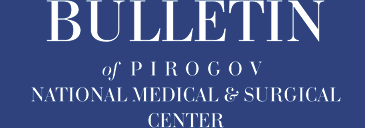Authors
Bogdanov A.V.1-3, Prudkov M.I.2, 3
1 Ural State Medical University, Ekaterinburg
2 Ural Institute of Healthcare Management named after A.B. Blokhin, Ekaterinburg
3 Sverdlovsk Regional Clinical Hospital № 1, Ekaterinburg
Abstract
Summary: Surgical treatment of women suffering from rectocele of 2–3 degrees is a pressing issue. Such patients suffer from severe defecation disorders and are concentrated in proctology departments. For rectocele correction, local tissue plastic surgery is most often used, which involves removing excess vaginal mucosa and suturing portions of the levator muscles. The disadvantage of this method is the high relapse rate. The use of mesh implants significantly reduces the relapse rate, but their installation is associated with the risk of infection, contact erosions of the vaginal mucosa progression and the formation of fistulas that can disable patients.
Aims: The method for plastic surgery of the rectovaginal septum developing with a mesh implant protected from contact with the vaginal mucosa and evaluation of its applicability in patients with lower rectocele of 2–3 degrees.
Materials and methods: In the Proctology Department of the State Autonomous Healthcare Institution of the Sverdlovsk Region “Regional Clinical Hospital No. 1”, 78 patients with grade 2–3 lower rectocele were treated. The first group consisted of 38 patients who underwent standard technology of rectovaginal septum plastic surgery with local tissues. The second group consisted of 40 women who were treated using a modified technique. The clinical picture before and after surgery, the duration of the intervention, the frequency and severity of postoperative complications, and the dynamics of clinical manifestations after 3 months were assessed.
Results: Women in both groups suffered from severe defecation disorders requiring manual assistance. The duration of the operation in the first group was 60 [49; 68] minutes and in the second – 65 [50; 70] minutes (p = 0.226). The patients of the first group had 9 complications of the postoperative period of class II and IIIb according to the Clavien-Dindo classification, the women of the second group had 3 complications related to class II and IIIa, while the average severity of complications was lighter than in the first. The decrease in the severity of complications in patients of the second group is probably due to the unloading of the stitched levators by the implant, preventing the cutting of the sutures applied to them, the formation of seromas and hematomas.
On examination after 3 months, 92.2% of women of the first group did not have an anatomical defect in the rectovaginal septum, and 3 patients had a relapse of the disease. 97.4% of women showed an improvement in defecation and only one patient was forced to return to manual assistance. At the same time, after 3 months, 95% of patients of the second group did not have a rectocele. All women of the second group defecate without the use of manual assistance.
Conclusions: The modified alloplasty method is applicable and effective in 95% of patients with lower rectocele, is easily tolerated and contributes to a more comfortable course of the early postoperative period. Sutured levators in front of the mesh implant protect it from contact with the vaginal mucosa, which reduces the risk of bedsores and vaginal fistulas.
Keywords: rectocele, mesh, surgical meshes, rectum.
References
1. DeLancey JO. Anatomic aspects of vaginal eversion after hysterectomy. Am. J. Obstet. Gynecol. 1992; 166: 1717-1724.
2. Khitaryan AG, Dulyerov KA, Stagniev DV, et al. Correction of pelvic prolapses in patients with rectocele and constipation caused by obstructive defecation. Bulletin of surgical gastroenterology. 2016; 3: 143. (In Russ.)
3. Aliyev EA. Pelvic organ prolapse (literature review). Coloproctology. 2016; 56(2): 42-47. (In Russ.)
4. Fomenko OYu, Shelygin YuA, Popov AA, et al. Dysfunction of rectal emptying in patients with genital prolapse. Russian Bulletin of Obstetrician-Gynecologist. 2018; 18(5): 67-72. (In Russ.) doi: 10.17116/rosakush20181805167.
5. Shelygin YuA, Titov AYu, Dzhanaev YuA, et al. Peculiarities of the clinical picture and the nature of neuro-functional disorders in patients with rectocele. Coloproctology. 2012; 42(4): 27-32. (In Russ.)
6. Lukyanov AS, Kostarev IV, Frolov SA, et al. Remote results of surgical treatment of rectocele by the method of rectovaginal septum plastic surgery with a W-shaped mesh implant. Surgeon. 2024; 3-4: 39-48. (In Russ.) doi: 10.33920/med-15-2402-04.
7. Khitaryan AG, Dulyerov KA, Pogosyan AA, et al. Anatomical and functional state of the pelvic floor muscles and rectovaginal septum in women with posterior pelvic prolapse and rectocele. Practical Medicine. 2013; 67(2): 90-94. (In Russ.)
8. Lukianov AS, Biryukov OM, Goncharova EP, et al. Rectocele repair with a W-mesh. Koloproktologia. 2022; 21(2): 81-90. (In Russ.) doi: 10.33878/2073-7556-2022-21-2-81-90.
9. Krivchikova AP, Yarosh AL, Oleynik NV, et al. Method for optimizing surgical correction of rectocele by transvaginal access. Immediate and remote results. Bulletin of Experimental and Clinical Surgery. 2023; 16(1): 33-39. (In Russ.) doi: 10.18499/2070-478X-2023-16-1-33-39.
10. Patent RUS №2570764/10.12.2015. Byul. №34. Oshchepkov AV, Bogdanov AV. Method of surgical treatment of third-degree rectocele. (In Russ).
11. Natroshvili IG, Baichorov EKh, Prudkov MI, Shulutko AM. Application of the integral index of severity of complications to optimize surgical treatment of mild and moderate acute cholecystitis. Medical Bulletin of the North Caucasus. 2019; 14(2): 312-316. (In Russ.) doi: 10.14300/mnnc.2019.14075.
12. Zarodnyuk IV, Tikhonov AA, Titov AYu, Mudrov AA. Defecography in the examination of patients with defecation disorders. Coloproctology. 2004; 8(2): 45-50. (In Russ.)


